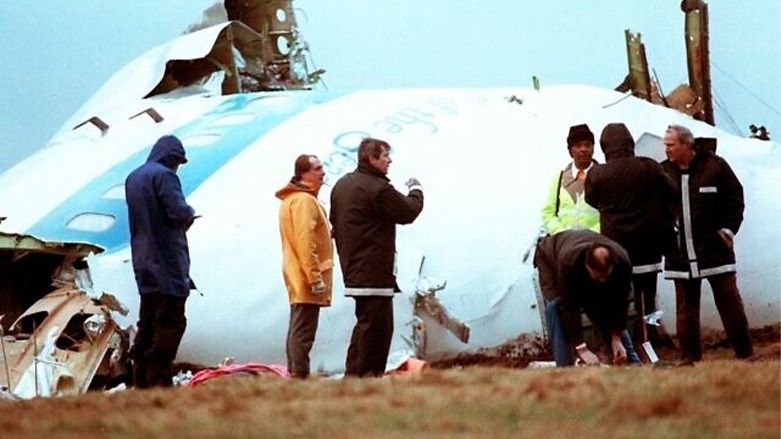Qaddafi-era agent appears in US courtroom for Pan Am 103 bombing

WASHINGTON DC, United States (Kurdistan24) A Libyan intelligence agent from the time of the country’s former dictator, Muammar al-Qaddafi, appeared in a courtroom in Washington DC on Monday.
Abu Agila Mohammad Mas’ud Kheir al-Marimi is charged with building the bomb that brought down the Pan Am103 airliner on Dec. 22, 1988, over Lockerbie, Scotland, killing 270 people.
Already in September 2012, following the 2011 overthrow of Qaddafi’s regime and the dictator’s death that October, Mas’ud, as US court documents refer to him, was detained by the new Libyan authorities.
Mas’ud confessed that he had built the bomb that brought down the airliner. He had done so on the orders of Libyan intelligence, and following the bombing, he and two others, who were also involved, were thanked personally by Qaddafi.
Mas’ud, who rose to the rank of colonel in Libya’s intelligence service, also acknowledged having constructed the explosive device that was used to attack the LaBelle Discotheque in what was then West Berlin in the 1980s.
That assault caused the US to bomb Libya ten days later. As later became clear, the bombing of Pan AM 103 was part of Qaddafi’s revenge for the US attack that followed the nightclub bombing.
LaBelle Discotheque Bombing
The LaBelle Discotheque bombing occurred during what was still the Cold War, when Europe was divided into a pro-US bloc (essentially NATO) and a pro-Soviet bloc (the Warsaw Pact.)
US troops were based in West Germany to deter Soviet aggression, and the LaBelle Discotheque was popular with them.
The April 5, 1986, bombing of the nightclub killed three people: two US soldiers and a Turkish woman. It also wounded more than 200 people.
The US quickly recognized that Libya had been responsible for the bombing, as it had an intercept of communications between the Libyan embassy in East Berlin and Tripoli.
US President Ronald Reagan was tough in dealing with enemy states (many credit him with helping to bring down the Soviet Union), and ten days after the discotheque bombing, the US bombed nine sites in Tripoli and a tenth in Benghazi.
At the time, the US response was controversial, with several countries, including in Europe, saying that the available evidence did not support the US charge.
But less than a year later, a series of popular protests began in eastern Europe that caused the collapse of communism. East Germany disappeared, as did the Soviet Union two years later.
With that astonishing political change, the files of the East German secret police, the Stasi, suddenly became available to outsiders. They showed that the Reagan administration had been fully justified in attributing the LaBelle Discotheque bombing to Qaddafi’s regime.
Four people were subsequently convicted for their roles in the bombing by a German court: a Libyan diplomat, along with a Palestinian employee of the Libyan embassy, as well as a German man, born in Lebanon, and his German wife.
Bombing of Pan Am 103
The bombing of Pan Am 103 was the most lethal single terrorist assault on a US target until the 9/11 attacks. It remains the most lethal assault that the U.K. has ever experienced.
As US court documents explain, the bomb was placed in a radio-cassette recorder and packed in a suitcase, which was full of clothes. Investigators were able to track the clothes, and the bomb, to Malta.
The bomb-laden suitcase was placed on an Air Malta flight which flew to Frankfurt, West Germany, where it was transferred to a feeder flight for Pan Am 103. That feeder flight travelled from Frankfurt to Britain’s Heathrow Airport, where the suitcase was loaded onto Pan Am 103. Some 40 minutes into the flight from Heathrow to New York’s John F. Kennedy airport, it exploded.
The bomb-laden suitcase left Malta as unaccompanied baggage, and it remained as such in its onward flights. Commercial aircraft are not supposed to carry unaccompanied baggage. However, one of those involved in the plot—Lamen Khalifa Fhimah—was an employee of Libyan Airlines in Malta. That allowed him to circumvent the restriction on such luggage.
Fhimah was one of two Libyan intelligence agents charged earlier for involvement in the bombing. However, the Scottish trial court which heard the proceedings acquitted him for lack of evidence, although it did find the other defendant—Abdel Baset Ali al-Megrahi—guilty.
Like Fhimah, Megrahi worked for Libyan Airlines: as Chief of Security—a most convenient cover! He died in 2012 from prostate cancer, at the age of 60.
Court documents also revealed some personal details about Mas’ud. He was born in Tunisia, but raised in Libya. He joined Libyan intelligence in 1973, at the age of 22, and worked as a “technical expert” building explosive devices.
